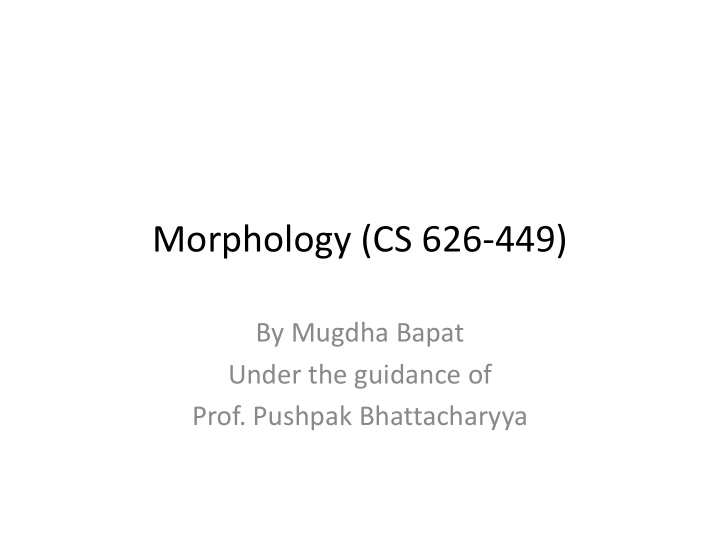



Morphology (CS 626-449) By Mugdha Bapat Under the guidance of Prof. Pushpak Bhattacharyya
What is Morphology? • Study of Words – Their internal structure washing wash -ing – How they are formed ? bat bats rat rats write writer browse browser • Morphology tries to formulate rules
Morphology for NLP • Machine Translation ����� , Noun, Direct Case, Plural Analyze Generate Transfer ि����� : ि���� , Noun, ����� � Direct Case, Plural • Information Retrieval – goose and geese are two words referring to the same root goose
Need of MA and MG • Why not list all the forms of a word along with their features? – Drink: – drink, V, 1 st person – drink, V, 2 nd person – drink, V, 3 rd person, plural – Drinks: drink, V, 3rd person, singular – Drank: … – Drunk: … – Drinking: …
Need of MA and MG • Reasons: – Productivity: going, drinking, running, playing • Storing every form leads to inefficiency – Addition of new words • Verb: To fax. Forms: fax, faxes , faxed, faxing – Morphological complex languages: Marathi • ������������ �� – ��� (SG)+ ���� + �� (PL)+ �� Meaning: ������ �� � ������ �������� • Polymorphemic • Possible to store all the forms?
Morphemes • Smallest meaning bearing units constituting a word Stem Morphemes Suffix Prefix consider ation re Stem Affixes reconsideration tree, go, fat Prefixes Suffixes Affixes in post - Hindi? -ed (tossed) (postpone)
Classes of Morphology • Inflection • Derivation
Inflection • Indicates some grammatical function like ���� (D) ��� � (O) � Case ���� (Sg) ��� � (Pl) Number ����� ��� � �� (1 st ) Person (2 nd ) ��� � �� (Masc) ��� � �� (Fem) Gender ��� (Pas) ��� � �� (Fem) Tense • Results in a word of the same class • Productivity
Derivation • Usually, results in a word of a different class • -able when attached to a verb gives an adjective • read (V) + -able = readable (Adj) • Often meaning of the derived word is difficult to predict exactly • writer :: writer (one who writes) • paint :: painter (one who paints) • cut :: cutter? (an instrument used to cut) • Less productive – eatable :: readable :: runnable?
Problems in MA • Productivity • False Analysis • Bound Base Morphemes
Productivity • Property of a morphological process to give rise to new formations on a systematic basis Transitive Verb Productive -able (read) (readable) Not Noun (game) -able Productive (gameable) • Exceptions Peaceable Actionable Companionable Saleable Marriageable Reasonable Impressionable Fashionable knowledgeable
False analysis hospitable, sizeable They don’t have the meaning “to be able” They can not take the suffix -ity to form a noun Analyzing them as the words containing suffix -able leads to false analysis
Bound Base Morphemes • Occur only in a particular complex word • Do not have independent existence base morpheme Compound (nonexistent) (known) malleable • -able has the regular meaning “be able” • -ity form is possible feasible • Base words don’t exit (fease+ible) independently
More on Inflection Noun inflectional suffixes • Plural marker -s • Possessive marker ‘s Verb inflectional suffixes • Third person present singular marker -s • Past tense marker -ed • Progressive marker -ing • Past participle markers -en or –ed Adjective inflectional suffixes • Comparative marker -er • Superlative marker -est Inflectional Suffixes in English
Spelling Rules • Generally words are pluralized by adding –s to the end • Words ending in –s, -z, -sh and sometimes –x require –es – buses, quizzes, dishes, boxes • Nouns ending in –y preceded by a consonant change the –y to -i – babies, floppies
Verbal Inflection Morphological Regularly Inflected Verbs Irregularly Inflected Verbs Form Classes Stem Jump Parse Fry Sob Eat Bring Cut -s form Jumps Parses Fries Sobs Eats Brings Cuts -ing participle Jumping Parsing Frying Sobbing Eating Bringing Cutting Past form Jumped Parsed Fried Sobbed Ate Brought Cut –ed participle Jumped Parsed Fried Sobbed Eaten Brought Cut Forms governed by spelling rules Idiosyncratic forms
Morphological Parsing • Finding – Constituent morphemes – Features Input Morphological Parsed Output cats cat +N +PL geese goose +N +PL goose (goose +N +SG) or (goose +V) gooses goose +V +3G caught (catch +V +PAST-PART) or (catch +V +PAST)
Resources Lexicon List of stems and suffixes along with basic information about them Morphotactics A model of morpheme ordering that explains which classes of morphemes can follow other classes of morphemes Orthographic Rules Spelling rules used to model the changes that occur in the work usually when two morphemes combine
Morphological Recognition reg-noun irregular-sg-noun irregular-pl-noun plural Lexicon flower goose geese -s cat sheep sheep dog mouse mice
Morphological Recognition: Nouns reg-noun irregular-sg-noun irregular-pl-noun plural Lexicon flower goose geese -s cat sheep sheep dog mouse mice plural (-s) reg-noun q1 q2 q0 FSA Note: Here, we are ignoring the nouns which take the suffix irreg-pl-noun –es for pluralization irreg-sg-noun
Adjectives Type Properties Examples adj-root1 Occur with un- and -ly happy, real Adj-root2 Can’t occur with un- and big, red -ly
Adjectives Type Properties Examples adj-root1 Occur with un- and -ly happy, real Adj-root2 Can’t occur with un- and big, red -ly adj-root1 -er -ly q1 q2 -est un- q0 q5 adj-root1 ε -er q3 q4 -est adj-root2
References • “Linguistics, An Introduction to Language and Communication” by Adrian Akmajian, Richard A. Demers, Ann K. Farmer and Robert M. Harnish (5th Edition) • SPEECH and LANGUAGE PROCESSING, An Introduction to Natural Language Processing, Computational Linguistics, and Speech Recognition by Daniel Jurafsky and James H. Martin (Second Edition)
Recommend
More recommend